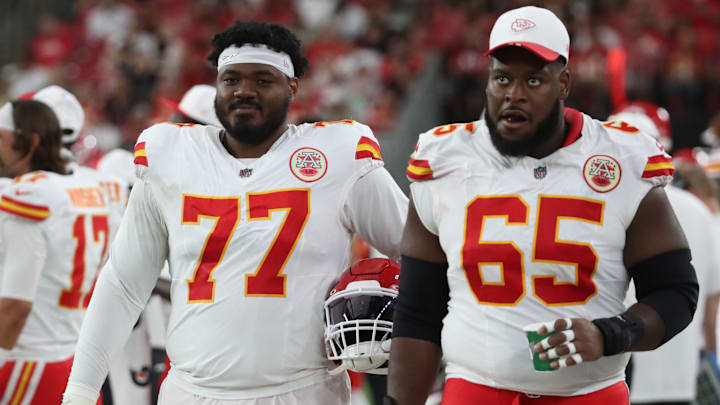The vibe throughout the Kansas City Chiefs' offseason was filled with optimism. It felt as if the front office had rolled a brand-new, custom-built offensive lineman straight off the showroom floor and handed him the keys. And it was a high-performance model acquired to protect the franchise’s most valuable asset, Patrick Mahomes. Fans were ready to cruise.
Then, the preseason began. The narrative quickly shifted. That expensive new piece, Jaylon Moore, hasn't quite delivered the fireworks everyone expected. His $30 million contract is now a central topic of conversation, and not for the reasons the Chiefs hoped.
Chiefs' Shifting Depth Chart Has Affected Jaylon Moore's Outlook
Moore was signed in March to be the answer at left tackle. However, the Chiefs’ draft strategy changed everything. Selecting Josh Simmons in the first round immediately created competition. And Simmons didn’t just compete: He excelled.
He allowed zero pressures in 26 preseason pass-blocking snaps. Consequently, Moore found himself in a battle he wasn’t winning. And the plan for Moore quickly unraveled.
He was suddenly taking practice reps at guard, a position he hasn’t played professionally. Head coach Andy Reid's move signaled a significant demotion on the depth chart. His versatility is valuable. But that’s not what the team paid $15 million a year for, and this situation has left people scratching their heads. Besides, the financials are hard to ignore.
Moore’s 2025 cap hit is over $11 million. That is more than All-Pro center Creed Humphrey ($10.79 million). This creates a major salary cap imbalance for a player who isn't a clear starter. The investment was made for a cornerstone, not a utility player.
Moore’s performance on the field was just okay. Film reviews from the preseason games favored the rookie Simmons. They showed Moore struggling to consistently outperform other veterans. For a contract of that size, "just okay" feels a lot like a letdown. The value simply isn’t matching the cost so far.
His Pro Football Focus grades also weren't special, as he finished with a 70.6 pass protection mark, whereas Simmons finished with an 84.1 as a pass blocker.
What This Means for Moore's Future with the Chiefs
This isn't to say Moore is a lost cause. The team praises his technique and attitude.
"He's a good football player... we only have five spots, so you gotta try to move people around it and make sure they can do everything here," Reid said in late July about Moore.
Moore does bring experienced depth to a unit that was decimated by injuries last year. And this versatility could prove crucial over a long season. So, there is still a path for him to contribute meaningfully. However, the immediate return is disappointing.
The Chiefs seemed to have essentially paid starter money for a backup. This miscalculation impacts their financial flexibility moving forward. It forces them to rely heavily on a rookie, which is always a gamble in the NFL.
Moore himself is saying all the right things. “It’s the NFL; things happen,” he stated in early August. “I’m just trying to be in the best position to kind of help move the team forward.” This team-first mentality provides a silver lining to this cloudy situation. Besides, he regular season will be the true test.
Injuries are inevitable in this league. Moore will undoubtedly get his chance to play significant snaps. When that moment comes, he must prove his worth and show he can be the player Kansas City thought they were buying.
The signing feels like a strategic miss for now. The hope is that Moore can evolve into a reliable Swiss Army knife. The Chiefs’ front office is betting on his long-term potential. But the initial returns have certainly let Kansas City down.
Chiefs Kingdom wants rings, not receipts. If Moore turns into the super-sub who saves Mahomes in December, this story flips. Until then, the $30 million question lingers like smoke over Arrowhead.
